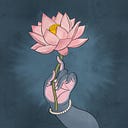Goddess Mahābhairavi
The sculptural art of Kashmir, closely related to that of the adjoining state of Himachal Pradesh, generally shows the combination of Gupta, Pratihāra and Pāla art traditions with perceptible influence from Gandhāra and Central Asia. The reason for this mingling of different art traditions may be that, besides the political activities of the kings of various dynasties, the migration of artists and scholars from one place to another also greatly influenced the artistic traditions of different regions of the country.
In this stunningly detailed brass sculpture, the Goddess Mahābhairavi with ten arms and four heads is seated on a male with four arms, who in turn sits with his legs crossed at the ankles on a lotus. Like those of the Goddess, his head is adorned with a tiara of skulls. His face is turned toward the goddess and his forehead bears the third eye. Two of his hands form the añjalīmudra and the other two support the Goddess. One of her four faces is fearsome, but the others are benign and attractive. Her emblems include a sword, a battle-ax, a skull cup held below her breasts, and a manuscript. Some of her other weapons are unfortunately broken, and only the feet of two attendant figures remain attached to the top of the rectangular pedestal. This goddess represents one of the eight forms of Mahābhairavi, who are manifestations of Durga and consorts of the corresponding eight Bhairavas, the ugra (fearsome) aspects of Śiva. What is curious about this image, however, is that one of the Bhairavas acts as a mount for the Goddess, thereby clearly indicating her superiority — reaffirming the descriptions of the Goddess in tantric texts. This particular sculpture may have been crafted locally or in the neighbouring region of Chamba, which has an ancient tradition of bronze casting.
Bhairavi is described in literature as having a fierce appearance; her primary role in the cosmic process is destruction. Her complexion is said to be as bright as thousands of rising suns. She wears a garland of skulls and clothes made from the skins of demons she has killed; her feet and breasts are covered with blood. Her four hands hold a rosary and a book and make the signs of fearlessness and granting wishes. The Kālikā-purāṇa says that her eyes roll from intoxication and that she stands on a corpse.
In her thousand-name hymn from the Visvasāra-tantra, Bhairavi has several names that identify her with philosophical or cosmic absolutes. She is called Parameśvari (mistress of all), Jaganmāta (mother of the world), Jagaddhatrī (she who nourishes the world), Parama (she who is the highest), Parabrahmasvarupiṇī (she whose form is the highest brahman), and Sṛṣṭisarhharakāriṇī (she who is the cause of creation and destruction). These names, like her many forms, emphasize that she is a complete goddess, as it were, not just a goddess associated with destructive energy.
In Tantric literature, the goddess elevated to the highest position. Ānandabhairava or Mahā-bhairava, which are epithets of Śiva, is the soul of, or is composed of, the nine collections of things of which the world is made up, such as time and its various forms (Kālavyūha), existing things like the blue substance (Kulavyūha), names (Nāmavyūha), perception (Jñānavyūha), the five faculties, viz. consciousness, heart, will, intelligence, and mind (Cittavyūha). Mahābhairava is the soul of the goddess; therefore she also is the soul of, or composed of, the nine components, and both of them together, therefore, constitute one entity. When there is Sāmarasya, or community of joy or intense love between them, creation follows. The female element, or Mahābhairavi, however, is predominant in the process of creation and the male element, or Mahābhairava, in the work of destruction.
References
Pal, Pratapaditya. Bronzes of Kashmir. Austria: Hacker Art Books, 1975.
Bhandarkar, R. G.. Vaiṣṇavism, Śaivism, and Minor Religious Systems. India: Munshiram Manoharlal Publishers, 2001.
Kinsley, David R.. Tantric Visions of the Divine Feminine: The Ten Mahāvidyās. India: Motilal Banarsidass, 1998.
_____________________________________________________________
If you find value in my work, I hope you consider becoming a patron or making a contribution to hindu.aesthetic@okicici. Hindu Aesthetic requires a lot of time and effort and your support would mean that I can continue bringing you the best possible content. ❤
